The first tree I worked on at Aichi-en was somewhat unusual. The second tree I worked on made the first tree look easy. From a distance, the white pine looked unremarkable.

Japanese five-needle pine – front
The tree’s exposed roots were covered by foliage in the front, but easy to see from the back.
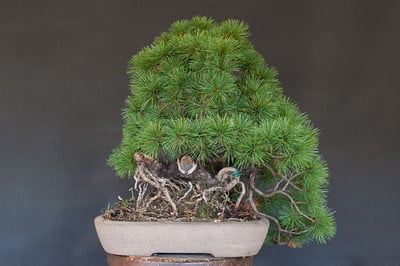
Japanese fine-needle pine – back
After looking closer, I realized that the foliage hid the tree’s true form. The trunk had been bent down until it crossed itself.
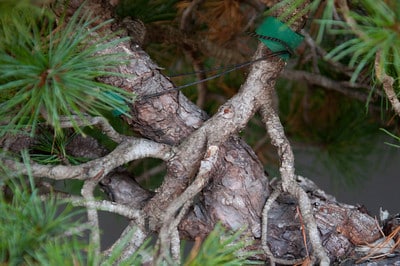
The tree’s apex crossing the trunk just above the roots
I didn’t have a clear idea what I’d do with the tree. “Very unusual tree,” Mr. Tanaka said with a big grin. I smiled and thought, “great.” As I did with the first tree I worked on, I began by removing the old needles. This gave me a chance to size up the tree and make a plan. Here it is after I removed the old needles.
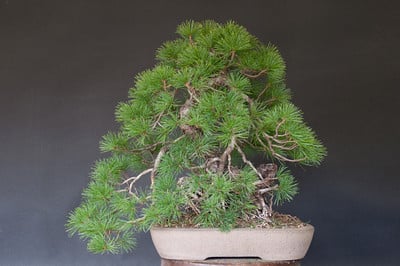
After removing the old needles
Before I started wiring, I made a case for shortening the apex where it crossed the middle of the trunk. Mr. Tanaka said to go ahead and cut it. Next came the wire.
For the first bend, I placed a screw directly into the trunk near the top of the tree and pulled it down using stainless steel wire. This made the tree more compact. I then wired the remaining branches, making a few cuts along the way. Here’s the tree after the initial wiring.
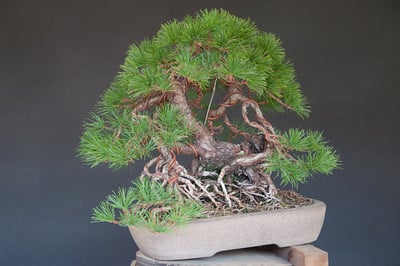
First pass – wiring complete
I wanted to make the apex smaller and I wasn’t sure about the lowest branch on the right, but I kept it to see what Mr. Tanaka thought. I had bent the branches enough that I didn’t want to tweak the tree anymore and I passed it to Mr. Tanaka for final adjustments. He removed two of the branches, one near the apex and the lower right branch, and then reset the rest, keeping the silhouette and basic style roughly the same.
I picked up a styling tip by watching Tanaka set the branches. He tended to bend the main branches way down, and the smaller branches out a bit. This made the tree a bit more compact while keeping nice branch pads. Here is the tree after Tanaka made these changes.
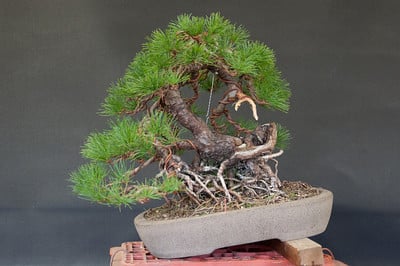
Styling complete
Because the tree is so unusual, I’d be curious to see how it looks several years from now. If it’s still at Aichi-en, I’ll be sure to get pictures.
Subscribe to Bonsai Tonight
New Posts Delivered Every Tuesday and Friday
Alex V says
While I love perfectly styled trees that have ideal proportions, it is nice to see the odd and different trees. They tend to be the ones that stand out in my mind as I am walking through an exhibit. Nice job Jonas, and good to see you are enjoying your stay in Japan!
Alex
Jose Luis says
Hello Jonas, I visited today for the first time your blog and the truth that I found very interesting, so I missed out above and are very good you do and reports and give explanations of the work realizas.Me Joseluis call’m from Madrid, this wonderful art levo 10 years I have a good tree colecioncilla funkiest and I’ll tell you more things and I look forward to your reports assiduously.
. Regards.
Jose L.
Jose Luis says
Hello Jonas,
I’m Jose Luis again and i only want to say I’m laughing because a I don’t know english and my wife say that I am saying rare things in my last message.
I’m sorry if you don’t understand me and I would like to know if you understand the spanish, so I could write in my language.
(this message has been written by my wife, ;-))
Regards
Jose L.
xwires says
Thanks Jose Luis – you are welcome to post comments en Español – entiendo un poquito!
Alex – Peter and I have noticed the same thing. It’s the rarities that capture the imagination, even the funky ones.
Juan says
SOme would call it unusual, others, perhaps less polite would just call it odd.
Odd or not, I like what you have done with it, It will be fun to see how it progresses.
Donde estas Senor Jonas?
xwires says
Ha – I’m fine with either label. I too found the tree odd but enjoyed trying to see what I could do with it. Sadly, I’m back home now, but I’ve many more photos and stories to share from the visit to Central Japan.